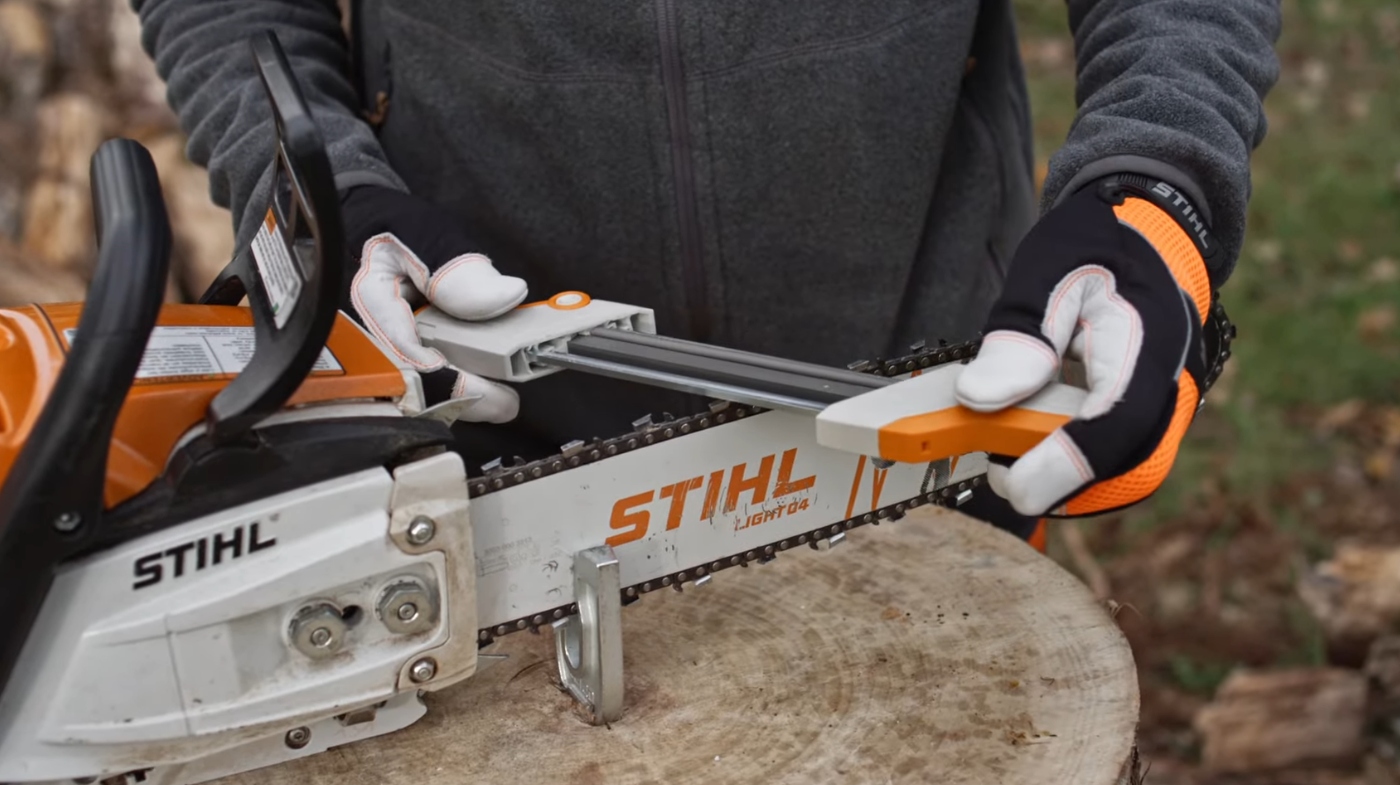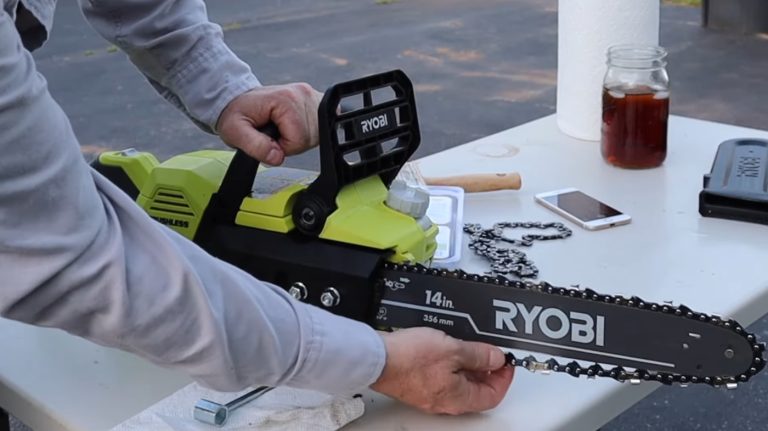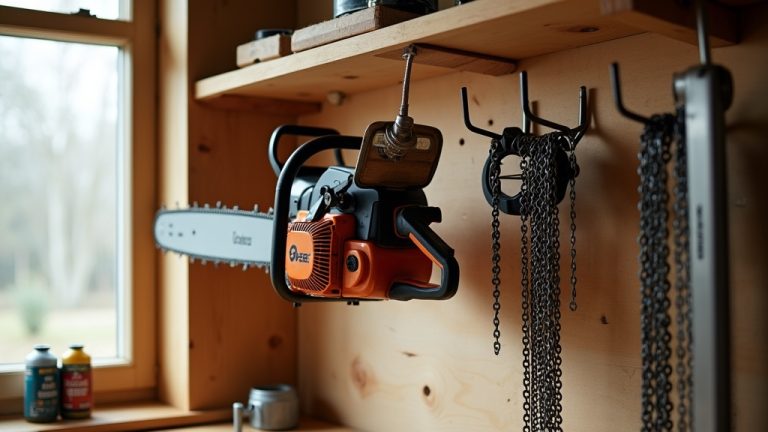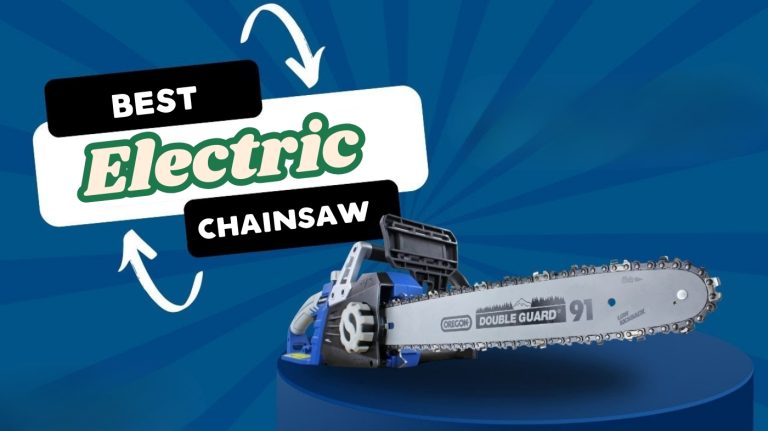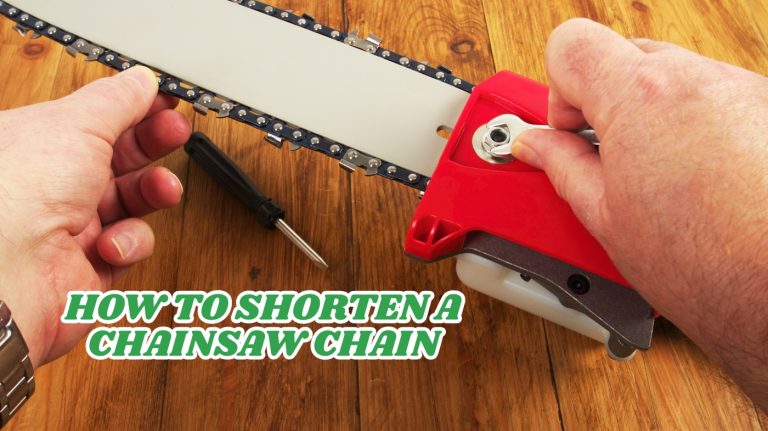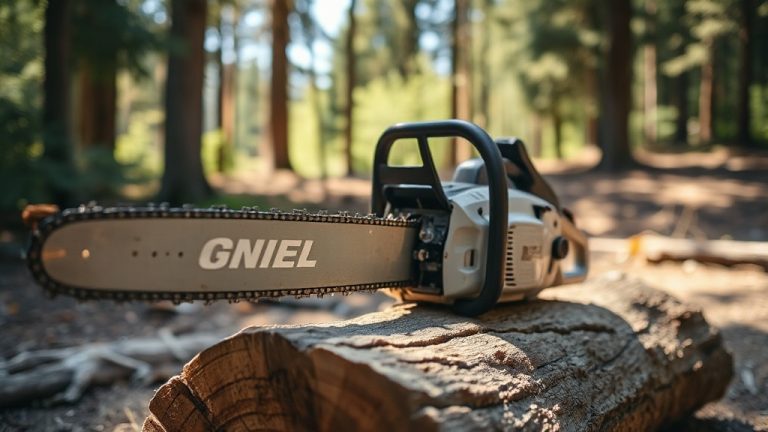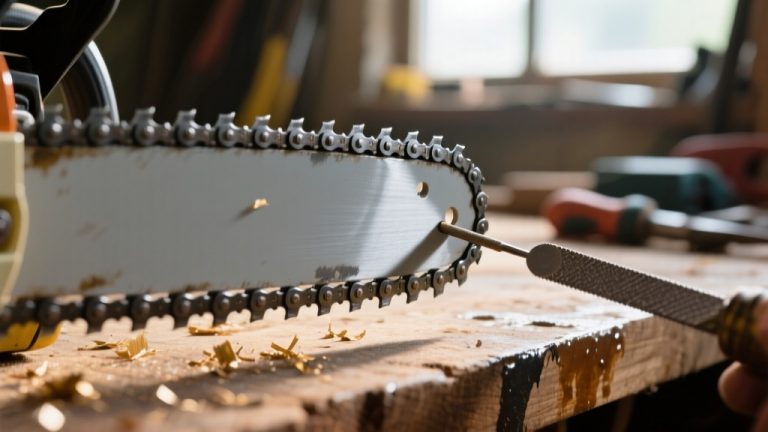How to Sharpen a Chainsaw? Step-by-Step Guide for Efficiency
To sharpen your chainsaw, first, gather the necessary tools like a round file, flat file, and depth gauge tool. Inspect the chain for any damage and clean it thoroughly.
Secure the chain in a vise, and file each cutter on the push stroke, maintaining a consistent angle. Adjust depth gauges for peak performance.
Regular sharpening enhances efficiency and safety. If you want to know more about techniques and maintenance, just continue exploring this topic.
Key Takeaways
- Inspect the chain for damage and clean it thoroughly before sharpening to ensure optimal performance.
- Use a round file matched to the cutter diameter and file only on the push stroke for even sharpening.
- Maintain correct angles (typically 25-30 degrees) using a file guide or sharpening jig throughout the sharpening process.
- Adjust depth gauges to ensure proper cutting depth and prevent kickback, checking them regularly for accuracy.
- Utilize a bench-mounted sharpener for efficiency and precision, ensuring the chain is securely clamped during sharpening.
Equipment Needed for Sharpening
To sharpen a chainsaw effectively, you need specific equipment that guarantees precision and safety.
Start with a round file that matches the cutter diameter for accurate sharpening. A flat file is essential for depth gauges, ensuring proper cutter height.
Use a file guide or sharpening jig to maintain the correct angle for consistency. Additionally, consider using an electric chainsaw sharpener that features a patented design for automatic chain sharpening, which can significantly enhance your efficiency.
Don’t forget the depth gauge tool for measuring and adjusting gauge height. Equip yourself with work gloves and safety glasses for protection.
For faster results, consider an electric chainsaw sharpener or a bench-mounted sharpener. Portable kits are also handy for on-the-go sharpening.
Inspecting the Chain Condition
Regularly inspecting the chain condition is essential for maintaining your chainsaw’s performance and safety. You should check the chain frequently, especially after it collides with foreign objects or shows signs of wear.
Here’s what to look for:
- Worn or damaged cutters
- Dull edges or rounded cutting edges
- Uneven wear patterns
- Loose or damaged drive links
- Blue discoloration on the bar indicating inadequate lubrication
A dull chain not only requires more force but can also lead to increased wear on the engine and bar. Additionally, ensure that all safety features are functioning correctly to prevent accidents during operation.
Ensuring Safety Measures
Before you start sharpening, it’s crucial to follow safety guidelines to avoid injuries and ensure optimal performance. Below are essential safety measures to keep in mind:
Engage Chain Brake
Engaging the chain brake is an essential safety step that every chainsaw operator should prioritize. This critical feature prevents the chain from moving during kickback or unexpected events, enhancing your safety.
- Chain Brake Mechanism: Stops the saw chain using a steel brake band.
- Engagement Process: Push the lever or guard forward until you hear a click.
- Safety During Start-Up: Start the chainsaw without the chain rotating.
- Disengagement Method: Pull the lever back towards the handle, keeping both hands on the chainsaw.
- Importance in Safety Protocols: Always check the chain brake as part of your pre-start safety measures. Chainsaw-related injuries predominantly occur due to failure to engage safety features like the chain brake.
Secure Workspace Properly
To guarantee a safe and efficient sharpening process, it’s essential to secure your workspace properly. Start by clamping your chainsaw in a sturdy vise, ensuring it’s fixed to a stable workbench.
This prevents any movement during sharpening, enhancing both safety and precision. Additionally, ensure that you have the right chain pitch for your file guide to maintain a consistent sharpening angle.
Clear away dust and debris from the chain using a soft-bristled brush, and organize your tools so they’re within easy reach.
Wear appropriate safety gear, including goggles, cut-resistant gloves, and sturdy clothing. If you’re using an electric chainsaw, unplug it or remove the battery before beginning.
Finally, keep your workspace free from sparks or flames, and have a first aid kit on hand. A secure and clean workspace sets the stage for an effective sharpening session.
Cleaning the Chainsaw Chain
Cleaning the chainsaw chain is essential for maintaining ideal performance and prolonging its lifespan. Follow these steps to guarantee thorough cleaning:
- Preparation: Gather materials like a paintbrush, soft cloth, and care oil. Wear sturdy work gloves.
- Chain Removal: Turn off the chainsaw and remove the chain and guide bar for effective cleaning.
- Debris Removal: Use a soft cloth or brush to eliminate loose debris from the chain.
- Oil Residue: Clean the oil outlet port and bar groove using a filing gauge or resin solvent.
- Household Method: Soak the chain in a mixture of baking soda and dish soap for an eco-friendly clean. Regular cleaning ensures optimal functionality and prevents premature wear, keeping your chainsaw performing at its best.
Understanding Chainsaw Teeth Types
After ensuring your chainsaw chain is clean and free of debris, understanding the types of chainsaw teeth becomes critical for optimizing your cutting performance.
Ensuring your chainsaw chain is clean is essential, but understanding the types of teeth is vital for optimal cutting performance.
You’ll encounter several types: full chisel cutters, which are aggressive and ideal for commercial use, and semi-chisel cutters, known for their durability and easier maintenance.
Low profile cutters serve specific tasks requiring precision. Additionally, round cutter teeth are easier to sharpen with a round file, making them a favorite among average users.
The shape of the teeth also matters; square teeth provide higher efficiency, while round teeth are less aggressive.
Additionally, consider material variations; carbide-tipped chains last longer in harsh conditions, while diamond-tipped chains excel in extreme environments.
Each type has its own application, so choose according to your cutting needs and the conditions you expect to face.
Proper Filing Techniques
Proper filing techniques are essential for maintaining your chainsaw’s cutting efficiency and prolonging its lifespan.
To sharpen your chain effectively, follow these guidelines:
- File stroke direction: File only on the push stroke, never on the pull.
- Apply pressure correctly: Pressure should go into the curve of the tooth, not downward.
- Make smooth passes: Keep each stroke smooth and level without rotating the file.
- Balance the chain: Confirm both left and right-facing cutters are sharpened evenly.
- Maintain file alignment: Align the file with the tooth’s cutting edge throughout each stroke. Additionally, regular filing after each cutting session helps to maintain cutting efficiency and ensures that the chain remains sharp for optimal performance.
Adjusting Depth Gauges
Sharpening your chainsaw’s cutting teeth is just one part of maintaining its efficiency; adjusting depth gauges plays an essential role in enhancing performance.
Depth gauges control how deeply the chain cuts into wood, impacting cut quality and safety. Use a depth gauge tool or a Dremel rotary tool to measure the height difference between the depth gauge and cutter tip.
Proper angles on cutting teeth enhance cutting efficiency, making it crucial to ensure both components are well-maintained.
Aim for a balance—gauge heights that are too high lead to poor performance, while those too low can cause kickback.
Using Bench-Mounted Sharpeners
When sharpening your chainsaw with a bench-mounted sharpener, it’s important to follow certain guidelines for efficiency and safety. Below are key tips to get the best results:
Setup and Preparation
When using a bench-mounted sharpener, the right setup and preparation are essential for achieving ideal results. Follow these steps to guarantee you’re ready to sharpen effectively:
- Remove the chain from the saw for easy access.
- Secure the chain in a bench vise to prevent movement during sharpening.
- Inspect the chain for wear or damage, and replace any damaged parts. Regularly checking for chain wear can help you maintain optimal cutting performance.
- Clean the chain thoroughly to remove debris that could hinder the sharpening process.
- Engage the chain brake to secure the chain in place while sharpening.
Operation and Technique
Achieving ideal results with a bench-mounted sharpener requires precise operation and technique.
First, securely set the saw chain in the sharpener’s vise. Adjust the grinding wheel angle to match your chain’s cutting angle, typically up to 35 degrees. The grinding stone angle allows for adjustments between 50 to 90 degrees, ensuring optimal sharpening.
Pull down on the upper handle to bring the grinding wheel into contact with the cutting tooth, sharpening each tooth in two to three seconds.
Sharpen every other tooth, then adjust the angle to sharpen the remaining teeth. After sharpening, visually inspect the teeth for uniform reflectivity. If necessary, adjust the depth gauge for peak performance.
Maintenance and Care
Maintaining your chainsaw with a bench-mounted sharpener is essential for prime performance and longevity. These sharpeners provide a reliable solution for keeping your chains sharp and efficient. Here are some key benefits:
- Consistency: Achieve uniform sharpness for prime cutting performance.
- Efficiency: Save time when sharpening multiple chainsaws or frequent use.
- Safety: Built-in safety features protect you while sharpening.
- Adaptability: Sharpen different chain pitches and angles effortlessly. The Timber Tuff Tools bench top sharpener is capable of sharpening chains from ¼” to 3/8” pitch.
- Durability: Extend the life of your chainsaw chains with precise cuts.
Tips for Effective Sharpening
Effective sharpening of a chainsaw requires attention to detail and consistency. Start by confirming each tooth is filed using steady, even strokes to achieve uniform sharpness.
Set your file guide at the correct angle, typically between 25 and 30 degrees, to maintain accuracy. Apply consistent pressure across all cutters to guarantee balance, and file each cutter the same number of times to prevent uneven wear.
Regularly sharpening your chain not only maintains peak cutting performance but also reduces effort while using the saw. Remember, frequent sharpening—ideally every time you refill gas and oil—will keep your chainsaw efficient and prolong the life of the chain.
Sharpening regularly also minimizes the effort required during cutting tasks and enhances overall safety. Prioritize these tips for effective results.
Maintaining Your Sharpening Tools
Proper upkeep of your sharpening tools is essential for consistent performance and safety. To ensure your tools remain effective, follow these maintenance practices:
Proper maintenance of sharpening tools ensures reliability and safety for optimal performance.
- Select the Right Material: Use high-carbon steel files for durability and sharpness.
- Check File Condition: Regularly inspect files for wear; dull files can lead to injury. Additionally, dull chains produce fine sawdust, indicating that your tools may not be effectively sharpening the chain.
- Store Properly: Keep files in a dry place to prevent rust.
- Limit Use: Reduce the number of strokes while filing to avoid heat buildup.
- Clean Electric Grinders: Clean after use to prevent sawdust buildup.
Frequently Asked Questions
How Often Should I Sharpen My Chainsaw Chain?
You should sharpen your chainsaw chain whenever it produces fine sawdust instead of large chips, or when you find it requires excessive force to cut.
Pay attention to safety; a dull chain can lead to accidents. If you notice smoke during cutting or uneven cuts, it’s time to sharpen. Your usage patterns, type of wood, and environmental conditions will influence how often you’ll need to sharpen, so stay vigilant.
Can I Use a Regular File Instead of a Chainsaw File?
You can’t use a regular file instead of a chainsaw file. Regular files lack the precise shape and size needed for sharpening chainsaw teeth effectively. They won’t maintain the necessary angles, leading to uneven cuts and dull edges.
Specialized chainsaw files are designed for durability and performance, ensuring your chain remains sharp and efficient. For best results, always choose the right file to match your chainsaw’s specifications and sharpen consistently.
What Are the Signs That My Chain Is Dull?
Ever wondered if your chainsaw chain’s lost its edge? You’ll notice excessive pressure’s needed to cut through wood, and the saw produces fine sawdust instead of larger chips.
Look for uneven cuts and increased vibration during use; these are clear signs of wear. If your chainsaw struggles or the engine overheats, it’s time to assess the chain’s sharpness.
Is It Necessary to Replace the Chain After Sharpening?
Yes, it’s necessary to replace the chain after sharpening if it shows significant wear or damage. Sharpening can restore cutting efficiency temporarily, but every chain has a limit to how many times it can be sharpened.
If you notice it’s close to the witness line or exhibits excessive wear, consider replacement. A new chain will cut more efficiently and safely, reducing strain on your chainsaw and enhancing overall performance.
Can I Sharpen Different Chain Types With the Same File?
Oh sure, just grab any file and think it’ll work wonders on every chain type. Unfortunately, that’s not how it goes. You’ll need specific files for different chains.
Round files suit semi-chisel and low-profile chains, while full chisel chains require square files. Using the wrong type can lead to ineffective sharpening and potential safety risks.
Keep Your Chainsaw Sharp with Regular Maintenance for Better Performance
Sharpening your chainsaw not only enhances its performance but also extends its lifespan. Did you know that a sharp chain can cut up to 20% faster than a dull one?
By regularly maintaining your chainsaw with proper sharpening techniques, you’ll guarantee efficient cutting and safer operation.
Remember, investing a little time in this process can save you both time and effort in the long run. Keep your tools sharp, and your work will be smoother and more enjoyable.

